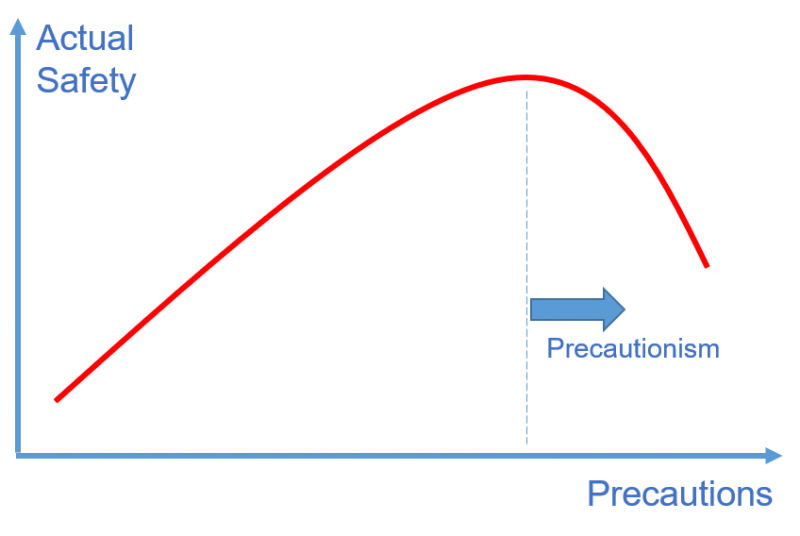
Do as I say not do as I do. Welcome to the Nassim Taleb fanclub. A group that has recently turned quite snarky when it comes to criticising institutions that don’t understand risk in the way that they do. The WHO in particular has come in for a lot of criticism from the Taleb wannabees in recent days for their ‘don’t wear masks’ advice.
The gist of this Taleban (too close to the edge?) argument has been that you don’t wait for evidence in order to decide to wear a seat belt. Wearing a seat belt, they will quite rightly argue – per the Precautionary Principle – can only help. There is an upside/downside asymmetry in favour of seat belts.
I posed the question whether any of the community also wore crash helmets and fireproof clothing when they got in their cars. The answer was a deafening silence. The sort of silence you get when someone realises their argument has a massive hole.
I didn’t even get to the part about data. The compiled data from the United States suggests that up to 3 % of vehicles involved in fatal crashes have a related fire event, and that over 5 % of fatalities occur in cars having caught fire, up to one third of the deaths being directly caused by fire. Surely, therefore, we should all drive in flameproof clothing. The Precautionary Principle says so. There’s only upside, right?
What the Taleban (I’ve decided I can get away with it…) don’t seem to understand, or want to understand is that we all draw the line somewhere. The line between precaution and precautionism. Nearly everyone wears a seatbelt, nearly no-one outside of motorsport wears flameproof overalls to go and pick the kids up from school.
The precautionary principle is good. But only up to a certain level. Somewhere along the spectrum of precautions we could take to mitigate risk the downsides start to outweigh the upsides.
The current should-I-shouldn’t-I debate over masks is happening, I think, because different people put the decision on different sides of the dividing line.
From a TRIZ/SI perspective what’s happening here is the debate serves to tell us there is a contradiction. We want precautions and we don’t want precautions. And if we’re smart, that should mean there is an innovation opportunity.

Before that’s possible, however, it’s a really good idea to arm yourself with the requisite facts. Another point that seems lost on the Taleband (how about with a ‘d’?) I tried to give them some actual facts regarding masks filters and Covid-19, but I guess it sounded and looked too technical to them, so they tried to pretend they hadn’t seen it. No-one likes to be outside their comfort zone. That’s why the WHO isn’t apparently listening to the Talebanned (too far? Or wrong way around – is this the name for people Taleb has blocked?). The WHO know epidemiology and healthcare but they clearly don’t understand systemic risk. Or, probably, the Precautionary Principle. Or, very definitely, the idea of solving contradictions.
But its exactly the same knowledge-blindness, stay-in-comfort-zone issue being seen from the Taleband. They’re clearly uncomfortable with not only epidemiology, but also thermodynamics and filter design technology.
Discomfort, however, is not a valid excuse for continuing to spout half-science. They might think there is only upside in what they’re suggesting, but when we add in the other half of the story, the downside can and in most cases does very easily outweigh the up. Precaution becomes precautionism.

This means, ultimately, they’re failing their own skin-in-the-game test. True, the most ardent of the Taleband have changed their Twitter thumbnail photo to now show them wearing a mask. ‘Look,’ they seem to want to say, ‘see how I’m practicing what I preach’. Some of these people have over 30,000+ followers. They might think that by recommending mask-wearing there’s no downside, but because, after you add in the actual science, in reality there is net downside, they’re potentially causing harm to lots of people. People who, when things do go wrong, rest assured the Taleband will be holding up their hands and saying, ‘nothing to do with me, mate, blame the Precautionary Principle’.
Every innovator, meanwhile, by definition, has to have genuine skin-in-the-game. They know that relying on half-science is a guaranteed whole way of ensuring they end up amongst the 98% of innovation attempts that fail.
Speed is important right now. Building parachutes after jumping out of the plane is a pretty good metaphor for the times. Last I heard though, there’s still time to read the parachute design manual before you jump.
The manual telling us that precautions are good, but too many precautions are not. Too many precautions mean a contradiction needs to be solved. Solving those contradictions helps put you in the 2%.
